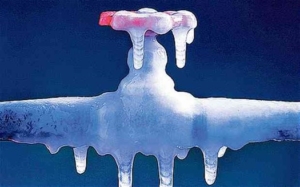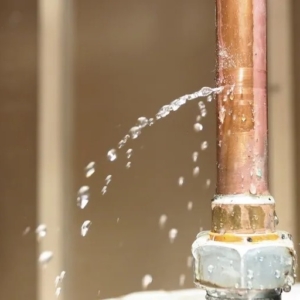Understanding and Preventing Pipe Bursts
What Causes Pipes to Burst?
Burst pipes are a major source of angst for property managers and insurers. It is a common misconception that pipes burst because the water inside the pipe freezes and then expands, causing the pipe to burst at the expansion point. This is not typically how pipes burst.
When water freezes inside a pipe, it creates an ice dam and the ice expands as noted above. As the ice expands inside the pipe it inhibits the passage of water. As the volume of trapped water increases, the pressure increases. Eventually the pipe bursts, typically not at the ice damming point, but rather at the pipe’s weakest point, releasing all of that built-up water pressure. This can sometimes result in hundreds, if not thousands of gallons of water pouring out from the pipe’s weakest point.
How long does it take for ice damming to occur?
Various factors determine the amount of time it takes for water to freeze inside a pipe. A few important factors include: duration and extent of freezing temperature, piping insulation, the general condition of the pipes and piping materials. As a general rule, air temperature in the area of piping must remain at 20° for approximately 6 hours in order for ice damming to become a risk to well-maintained piping. We must keep in mind, however, that pipes with little or no insulation could freeze in as little as 3 hours at the same temperature. As we mentioned above, the burst typically occurs at the pipe’s weakest point, so the condition of the pipe greatly affects the length of time and amount of pressure it takes to “burst”. Also, various piping materials affect the pipe’s ability to withstand a certain amount of expansion. Pex piping, for example is designed to expand under increased pressure, prolonging the amount of time and pressure needed to create a burst, but all piping materials have their limits.
The Weakest Link – Vulnerable Points in Piping
The weakest point may be exceptionally weak (where it should have been able to withstand the pressure) or it may be commonly weak (due to joints or connections which are naturally weaker than the pipes themselves). Here we delve into 3 common factors that contribute to weak pipes.
Corrosion
Corrosion is perhaps the most common cause of weakness, specifically in copper piping. According to the Foundation of Water Research, copper inherently has protective films which get broken down by water that has a high pH (often referred to as ‘hard water’), but this is not the only cause of corrosion. A few other factors that lead to corrosion include:
- Biofilms, a film housing bacteria inside the pipe
- Flux residues left in the pipe after installation or as a result of manufacturers defect
- High velocity or changing direction of water movement
- Construction defect, pairing incompatible metals
When the pipe is corroding it is called ‘cuprosolvency’, which means the dissolution of the copper surface. Cuprosolvency becomes visible on the exterior of the pipe when white or blue growth develops, indicating weakened areas of the pipe (pinholes) or around the joints. If the corrosion occurs in the pipe itself, a pinhole may develop, which is visible from the outside of the pipe.
If the area of piping is unavailable for visual inspection, looking below and around the pipe will often reveal evidence that a pinhole leak existed in that area. Water stains, fungus, mold and blistering, on the surfaces under the pipe indicate ongoing moisture, or a slow leak.
In newly constructed plumbing, an indication that corrosion is occurring typically manifests itself early on, as water may come out of the tap with a blue-ish hue and can taste metallic. Eventually, the white or blue build up will become evident on the exterior of the copper pipes (at the pinhole or at the joints) and even sometimes around the taps.
Improper Installation
Improper installation can create immediate weaknesses in the piping and joints or lead to corrosion, which over time weakens the system. These can appear similar to issues resulting from a manufacturer’s defect in an area of piping.
We performed a causation investigation that involved a burst sprinkler system in an eight-story building, which was under construction. Our expert noted that only the sprinkler joints and heads on the second floor burst, while the others remained intact. One might assume colder temperatures on the second floor caused this phenomenon. However, upon investigation it was established that the faulty installation existed on the second floor, which led to expansion fractures in the improperly constructed joints, elbows and sprinkler heads. Specifically, the wrong materials were used. The pipes on the second floor were considered “exceptionally weak” and unable to withstand the pressure created from the ice damming that occurred inside the pipes.
Building Envelope and Insulation
The building envelope, insulation, piping insulation, piping materials, indoor and outdoor temperatures and duration of those temperatures are all factors leading to pipe freeze, which leads to burst.
For example, we performed an investigation of a frozen pipe in a newly constructed movie theatre. It was determined that the pipe was a sprinkler line located in the soffit near an outside wall. The break caused significant water damage. The property owner stated that the contractor had not appropriately insulated the area to prevent the pipe freeze. The contractor stated that he had adhered to the designs and contract. Our expert inspected and learned that the property owner had three other theaters with the same construction. Ultimately, the problem pointed to improper design in the buildings where piping was installed too close to the exterior walls and both pipe and walls were inadequately insulated, allowing airflow from the outside. This combined with prolonged outside temperatures below freezing caused the pipe to burst, causing water damage to the newly constructed theatre.
Pipe Freeze Prevention
Understanding why pipes burst and what makes them weak can help us prevent burst pipes. Here are 6 key prevention methods:
- If there is piping in an area of the building that may reach temperatures below 40 F, leave faucet valves slightly open. Allowing a slow and steady drip will reduce the pressure that would otherwise be created by an ice dam.
- Building and pipe insulation – although this alone will not always prevent freeze, it will delay it. The building envelope, amount and distribution of the insulation in the building must be considered and there are several methods and materials used for insulating including: R-value/heat transfer, fiberglass insulation, natural insulation and foam insulation. Methods employed include box in methods, tent insulation or roof line and foam insulation.
- If a property is vacant or temporarily not in use, check to ensure the heating system is properly set and that it has adequate reserves. If the property is completely vacant and there is no use for water, then the most obvious and complete method of preventing a burst pipe is to turn the water off at the main and open all faucets, allowing them to flow until empty and leaving them open until the water is turned back on again. Supply lines are the source of the most significant water damage during pipe freeze as they are bigger with more volume accumulation.
- Develop a procedure to respond to loss of heat or electricity by identifying areas of the property that lose heat quickly and install a thermostat there so that you can ensure it remains above 40 F.
- Service heating systems regularly and check windows and doors to ensure there are no openings or breaks.
- Be aware that pipes are most susceptible to freezing when located in an outside wall, under a sink on an outside wall, and in an unheated crawlspace.
In conclusion, you can save yourself a lot of hassle and money by following these methods and understanding how pipe bursts occur.






